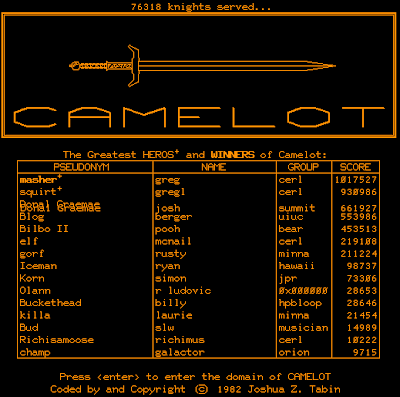From The CRPG Addict
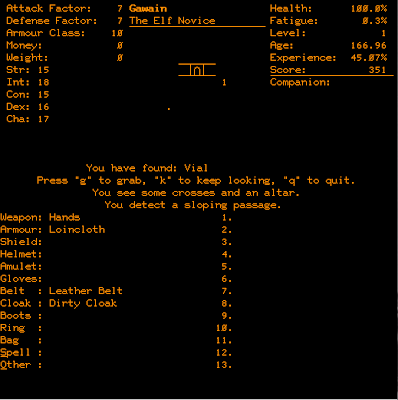 |
| Camelot has a single character exploring via a tiny first-person interface. It has more equipment slots and logistics than the typical RPG of the era. |
 |
| Camelot’s backstory mangles the Arthurian legend. |
Players can control only one character at a time, chosen from human, elf, dwarf, hobbit, ogre, and pixie classes. Each class comes with fixed attributes in strength, intelligence, constitution, dexterity, charisma, and maximum age. The plot, which makes no sense in context, is that the character is a Knight of the Round Table in search of the Holy Grail. It exists somewhere in a 10-level dungeon beneath a menu town. According to the documentation, you first need to get Excalibur from the Lady of the Lake.
Dungeon levels are 16 x 16, organized into rooms. Every space between two doors is considered a room, even if long, linear, and twisting. The moment you enter a room, there’s a chance of an encounter with monsters, treasure, or both. Some rooms have messages (“you notice an empty wallet on the ground”; “there is guano spread on the walls and floor”) that help keep you oriented. All active players are sharing the same dungeon, and once cleared, rooms remain so until the next level reset, which happens every hour or when the entire level is cleared.
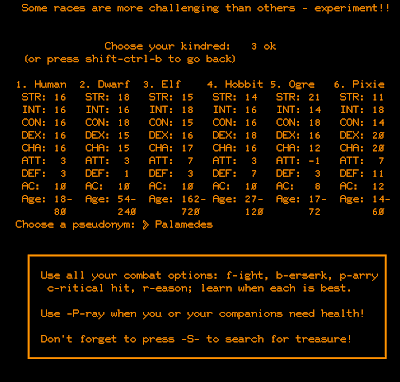 |
| Character creation. The different races have fixed attributes. I’m not sure how you live long enough to even get off Level 1 as a human, ogre, or pixie. |
It takes a long time to get any traction. A new character starts with his bare hands and a loincloth, and not enough money for much else. You have to get lucky with a few treasure rooms or combats before you can buy anything. Naturally, these early combats are pretty dangerous. You spend an awful lot of time running away and retreating back up the stairs to the inn, where you sometimes rest as long as a year to get back to full health. In more unfortunate cases, you die. The game’s permadeath is slightly blunted by relatively favorable odds for getting found and resurrected, although this comes with a loss of score, any money you were carrying, and sometimes an attribute.
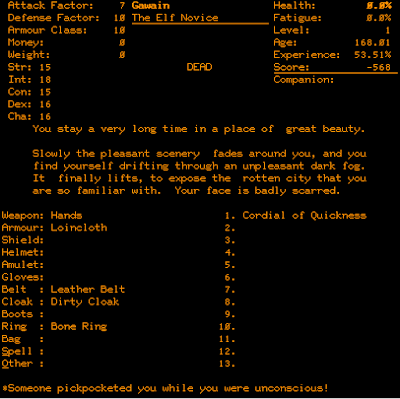 |
| I live, but I’ve lost a point of charisma. |
If the game excels in any particular area, it’s in its encounter design. When you enter a room, you’re told how many enemies you face, of what type (unless they surprise you, in which case you just get a category), whether they’re guarding treasure, and what their disposition is. A peace symbol suggests friendship while a sword shows they’re hostile.
Like a lot of games, you have numerous options for dealing with enemy parties, including three fight options (berserk, regular attack, and critical hit), parrying, reasoning with the enemies (which usually leads to them asking for money to go away), or attempting to steal their treasure out from under them. The good things is that no matter what option you try, you get experience even if it only partly works. There are plenty of times that paying a few hundred gold pieces to get the monsters to leave voluntarily is the best course of action, especially if the party is going to be difficult. Otherwise, they’ll remain in the room, blocking your progress, until the next reset.
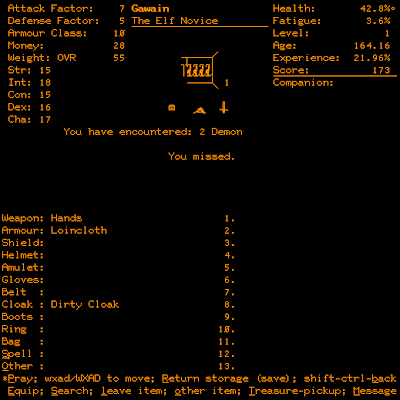 |
| Missing is the default outcome at Level 1. The demons guard a small treasure (the box to their left) and are hostile (the sword to their right). |
Combat is quasi-real-time rather than turn based. Dexterity determines how often you and your foes get to hit an attack key, but if you stand still and do nothing, enemies will keep attacking you rather than waiting for you to take your turn. The good news is that you can also simply run through the area–or turn around and flee–during this process, maybe taking a hit or two, but usually getting out of the area alive. With all these options, it’s often stubbornness that kills you.
Camelot has the most extensive equipment system of the PLATO games, with separate slots for weapon, armor, shield, helmet, gloves, belt, cloak, boots, ring, bag, spell, and “other.” The bag slot accommodates an increasing variety of bags that hold gold; otherwise, it’s very easy to get over-encumbered by coinage, with a consequent penalty to speed and accuracy in combat. You fill in the items slowly as you purchase them or, more commonly, find them in special treasure rooms. Scrolls and rings and such are the game’s only approach to magic. Particularly prized are manuals, which increase attributes permanently, and Potions of Youth, which reverse the affects of aging.
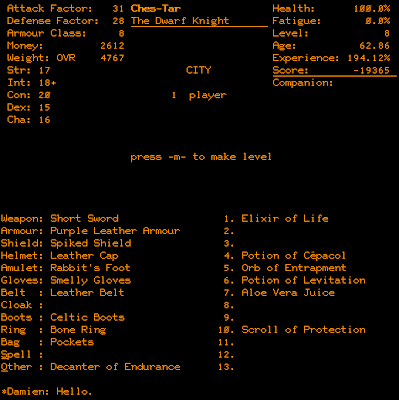 |
| My April character had amassed a lot of stuff, but a very low negative score. |
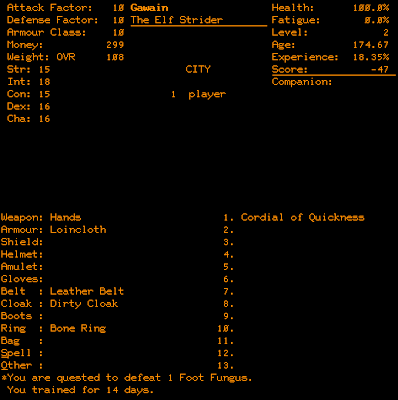 |
| I’ll need to kill a “foot fungus” before I can level up again. |
Until you find other items that allow you to heal, you can (P)ray several times per outing to restore anywhere from 10% to 50% of your health. I’ve never had it work more than 5 times. After that, you have to return to the town if you want to heal.
There are two teleporters that take you to fixed locations on the same level. There is one spinner in the middle of a 3 x 3 room with a message indicating it’s full of fog. There is one room that tells you it’s hot every round. There are two stairways down.
- When you enter the dungeon after each new hour (real-time) turns, there’s a chance–a good chance–that the dungeon will designate it “the witching hour!” and enemies will almost always get a surprise attack. In real life, only midnight is “the witching hour,” not every other damned hour. I think the witching hours may actually get more frequent as you get closer to Halloween.
- I’m having a weird graphic glitch where sometimes a weird graphic obscures the already-small game window. I’m not sure if this is deliberate or not. It seems to happen more often during a “witching hour.”
- There are more limited multiplayer options than in other PLATO titles, but they exist. Two players in the same room at the same time will attack the same enemy party and will then scramble for the treasure. You can have chats with other people in the dungeon. There hasn’t generally been anyone around during my explorations, but occasionally I’ve left the session running only to come back and find that someone tried a “Hello” while I was gone.
- There’s no automap in normal play, but you can “Follow” any active player and see his position on a map. If you have two Cyber1 accounts (I don’t), you can play with one account and follow your character with the other account, thus creating a de facto automap.
- There’s a way to tame some animals and have them as companions for a time.
- Unlike most other PLATO games, treasure doesn’t help much with experience. You have to defeat enemies. Treasure is important for buying equipment and leveling up, however.
I’ve already mapped Level 1, so what I do is every time the hour rolls around, I start shading the rooms I’ve already cleared. When the hour is up, I clear my shading and start over. I figure it’s time to move on to the next level when you can completely clear the previous one in an hour. I have a Level 4 character that is capable of clearing about 2/3 of Level 1 in an hour, but he’s died a few times and thus has a very high negative score. He also has yet to find a single weapon, and during his last resurrection, his dexterity got knocked from 18 to 16. I’ll still probably continue with him because it took me 4 hours just to get him to Level 4.
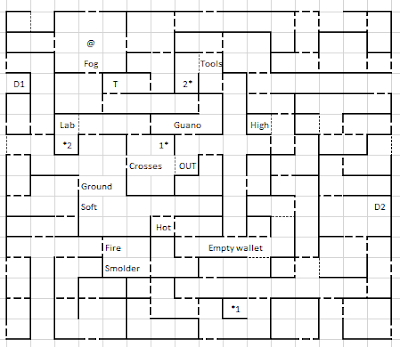 |
| 10% of the Camelot maze. |
Original URL: http://crpgaddict.blogspot.com/2019/10/game-343-camelot-1982.html

